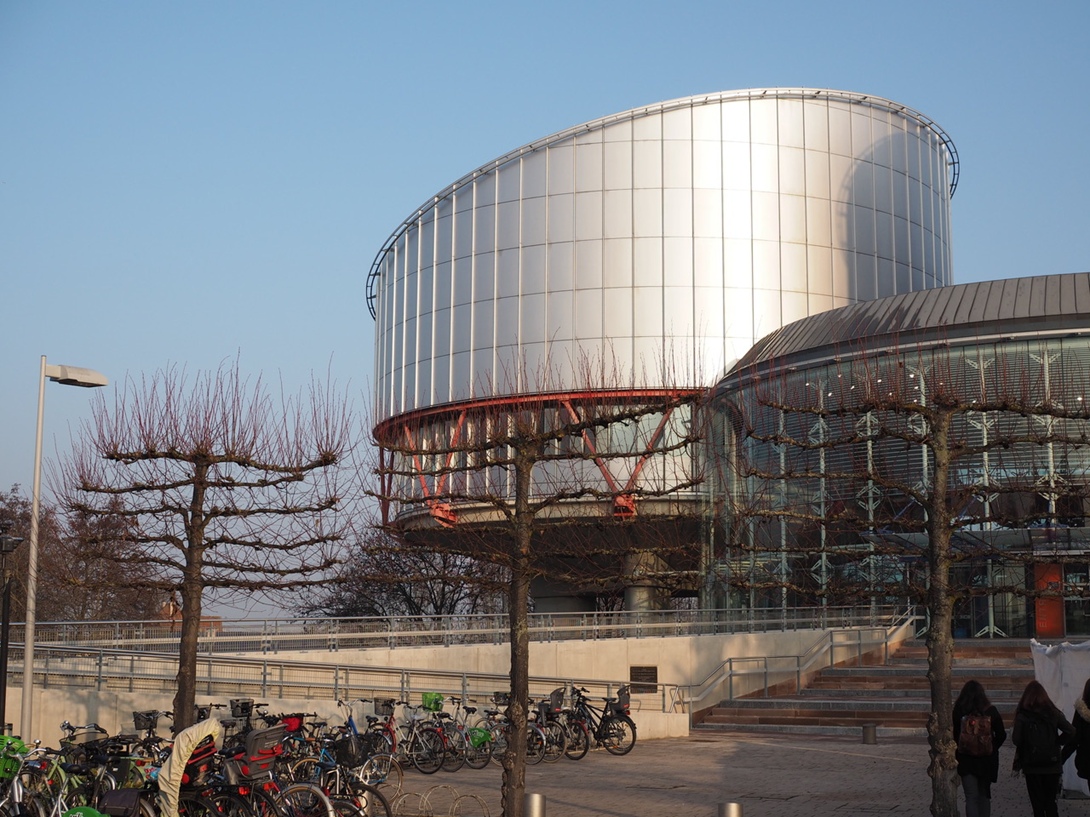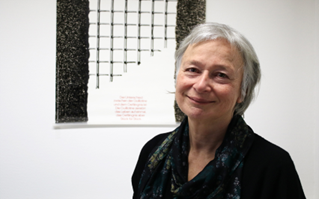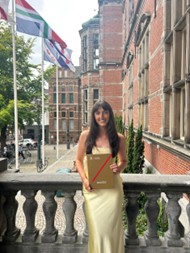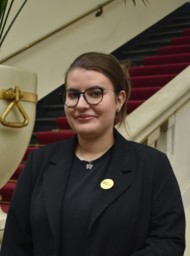
Credits: Antenor Hallo de Wolf
An interview with Wiene van Hattum on the implementation of the European Court of Human Rights judgments
By Shannon Kiernan, Rachael Smyth, Harpo Vogelsang, and Daria Stoianovici
As part of the International Human Rights Law in Practice course for the LL.M. International Human Rights Law at the University of Groningen, we had the privilege of interviewing Dr. van Hattum about the process of writing a Rule 9, par.2, submission to the Committee of Ministers.

Credits: University of Groningen
Dr. van Hattum is a Dutch lawyer specialized in criminal law and former assistant professor at the Faculty of Law of the University of Groningen. As a law professor, she taught criminal law courses focusing on the penitentiary laws in the Netherlands. Dr. van Hattum is the chairman of Forum Levenslang, an organisation concerned with protecting the interests of prisoners who have been sentenced to life without the option of parole. As part of this mission, Forum Levenslang has submitted several communications to the Committee of Ministers in the Murray v the Netherlands case before the European Court of Human Rights based on Rule 9, Par. 2, of the Rules of the Committee of Ministers for the supervision of the execution of judgments and of the terms of friendly settlements.
Dr. van Hattum, thank you for joining us in this interview. Could you elaborate on the founding objectives of Stichting Forum Levenslang (Forum) and how they have evolved since 2008?
Thank you for having me. I must be very humble, because I feel like a layman in this whole process. I was a criminal law practitioner, a lawyer, and never heard of Rule 9! I used the jurisprudence of the European Court of Human Rights, but I never realized there was a body to monitor the execution of those judgments.
The Forum Levenslang started in 2008 out of concern for life prisoners in the Netherlands. At that time, the prevailing message from politicians was that “life is life” – that life imprisonment meant never being released. That was a shift. In the past, life prisoners always had a prospect of release. I discovered this trend while teaching. I visited the prison in Norgerhaven monthly with my students, and there I met two life prisoners. One of them asked me: “How long is life imprisonment?” And I couldn’t give him an answer that would bring hope.
Historically, life sentences in the Netherlands were not without perspective. Pardons were common. But from 2004 on, things changed. The minister and parliament began repeating, “life is life”. That was the trigger for me. Also a prisoner sentenced to life is a human being. You can’t just forget someone. If no one cares, they are forgotten. We even found one prisoner whose name didn’t show up in the (Tulip-)system – he was invisible and therefor forgotten. Our goal was a more humane approach to life imprisonment.
And since its founding, what have been some of Forum’s key successes or challenges?
I would say the key success – or challenge, depending on how you look at it – was the change in jurisprudence by the Dutch High Court in 2017. That shift was triggered by the work of Forum Levenslang.
Of course, we don’t have any formal status as a non-gonvernmental organization, but what we did was asking questions to the minister, work with members of parliament to raise those questions, and share our vision in the media. And people were interested. We kept telling our story, again and again.
We were also helped by the Vinter judgment from the European Court of Human Rights in 2013 – a key case on life imprisonment. The Court ruled that any life prisoner must have a real prospect of release, that there must be a review after a certain number of years – 25 after imposition of the sentence – and that the prisoner must be treated with dignity.
But in the Netherlands, that judgment didn’t lead to any immediate change. So we kept pushing. We brought the issue to light, with help from MPs, and slowly the conversation started to shift. It was difficult to catch the attention of the media and more specifically to break through the ‘life means life’ assumption that was introduced by the government. In a letter to the editor we were called ‘hallucinating softies’.
Eventually, though, we influenced a High Court decision. In 2016 , the High Court (HR 5 juli 2016, ECLI:NL:HR:016:1325, NJ 2016/348, nt. Kooijmans, NbSr 2016/152 nt. Claessen) gave the minister one year to revise the existing policy on life imprisonment. And that led to the introduction of a formal review system for all life prisoners – something we had long been calling for. We call it the “review system”. To give you an impression of the scale of the problem: In 2000 there were around 10 life-sentenced prisoners in the Netherlands; when we started the Forum Levenslang in 2008 about 30; and now, in 2025, the number of lifers is over 60.
One of the tools available today to organisations like Stichting Forum Levenslang is the Rule 9, par. 2, submission process. Could you briefly explain its role in the execution of European Court of Human Rights judgments and why it is significant for civil society organisations?
Yes, of course – although I have to admit, this part was quite new for me. As a Dutch lawyer working in criminal law, I was familiar with case law from the European Court of Human Rights, like Vinter (2013) and Murray (2016). We often cited those rulings in our advocacy. But I didn’t know that there was an actual mechanism – Rule 9, par. 2 – for NGO’s and national institutions for the promotion and protection of human rights like the Forum, for following up on how judgments are implemented. That only came to my attention when I received an email from the European Implementation Network (EIN). They asked if we wanted to respond to the Action Plan submitted by the Dutch government in response to the Murray judgment. That’s when it all started.
At the time, I had never heard of this possibility. But we began working together with other non-governmental organisations – the NJCM (Dutch section of the International Commission of Jurists) and the Dutch Helsinki Committee. The three of us teamed up to draft a joint submission responding to the government’s action plan, which had been required because the Netherlands was found in violation of Article 3 in Murray.
Since then, the Government of the Netherlands wrote five action plans. Every couple of years, the government submits a new one. The most recent one I received – again thanks to EIN-information – was quite clear: the Committee of Ministers told the Netherlands that it needed to speed things up. They weren’t satisfied with the lack of progress and decided to place the case under enhanced supervision.
This is where Rule 9 becomes important. It allows NGOs to respond to those action plans and offer insights based on real-world experience. In our case, Murray was complicated because it involved a man detained in Curaçao and Aruba – the Dutch Caribbean, far away from the Dutch mainland. Mr. Murray was imprisoned for over 30 years in conditions not favorable for his psychological condition, with no psychological care, despite having a very low IQ and several disorders. He was simply not taken care of. One of the judges at the European Court said in a dissenting opinion that he had been treated “like human waste”. It was that inhumane.
The Grand Chamber – all 17 judges – unanimously ruled that the Netherlands had violated Article 3 of the European Convention on Human Rights (ECHR). But then came the question: did this judgment only apply to the Caribbean Netherlands, or did it also have implications for the European part of the Netherlands? That’s where our submission tried to shift the focus. We argued that the ruling should be understood more broadly – that it also reflected systemic problems within the European part of the Netherlands.
Unfortunately, our input on that point didn’t really gain traction yet. The Committee of Ministers seems to remain focused on the Caribbean side of things. Other NGOs, like NJCM, made stronger inroads there. We tried, but it’s difficult to know how submissions are received or what effect they have – that’s one of the challenges of this process. In our latest submission, that is on it is way to Strasbourg, we repeat our arguments that the Murray judgment affects the whole of the Netherlands since the Caribbean and the European part are intertwined as far as it concerns the execution of penalties.
I do think that Rule 9 is a powerful tool. It gives civil society a formal voice in the execution process and puts pressure on governments to follow through. Even if it doesn’t always succeed in the way you hope, it keeps the conversation going and builds a record. In our case, I am sure it helped push the case into enhanced supervision, which itself is a form of accountability.
You’ve already mentioned some aspects of the Rule 9 process. Based on your experience, what would you say are the key elements of a successful Rule 9 communication?
That’s an important question! I can’t say, since I have no prior experience.
One of the frustrating things about Rule 9 submissions is that you don’t know how your input is received or what kind of impact it has. You’re putting in a lot of work – consultations, drafts, submissions – but there’s no clear feedback or indication of how it’s taken up. That I find difficult in our case.
My main point was that the ruling should not be limited to the Caribbean Netherlands – Curaçao and Aruba – but that it should apply more broadly, including to the mainland Netherlands. I believed this was a critical point, but unfortunately, it did not gain much traction yet. We did try to push the issue repeatedly – highlighting the poor conditions in Curaçao and Aruba and the need for broader systemic reform – but in the end, the Committee of Ministers placed only the Caribbean part of the case under enhanced supervision. That was a disappointment for us.
Still, I believe that one of the most important things an NGO can do is to respond to the government’s action plans. If a plan is inadequate, then civil society is in a unique position to speak from the ground, to offer real facts, cases and insights that might not be reflected in official reports. That’s what we try to do. Just as we helped shift the view of the Dutch High Court back in 2017 through public pressure and parliamentary questions, NGOs can also influence international supervision processes – but only if they bring clear, grounded input.
Of course, that only works if you truly know the subject matter. In our case, I could not speak with authority about the situation in the Caribbean – that’s not where our expertise lies. So perhaps that’s where another NGO should take the lead now. But the principle remains: Rule 9 submissions work best when they are built on solid, specific knowledge – and when they are used to highlight what’s missing or unjust in a government’s response.
Beyond individual cases, can Rule 9 submissions contribute to broader legal or policy change? Have you seen examples of this in your work?
I believe they can. I’m sure that other NGOs – especially those working in other subject areas – could make effective use of Rule 9 communications to support broader legal reform. But for Forum Levenslang, that has not yet been possible in this case.
There are, however, seven new cases pending against the Netherlands, and those are directly related to life imprisonment and Article 3 ECHR violations here on the mainland. The Court has put several questions to the government, and perhaps one day these cases will intersect – maybe something will come together through different channels.
One complicated issue has been the government’s repeated references to a future TBS system (a therapeutic detention framework) in the Caribbean Netherlands. The Committee of Ministers has now asked the authorities to clarify how relevant that is – whether TBS orders are actually available to life prisoners and how such measures would prevent future violations.
But here’s the reality: there is no TBS ‘system’ yet in the Caribbean since there is no forensic clinic. And even in the Netherlands, the TBS measure is not being properly used for life-sentenced individuals (see my 2017 paper, 9-12). The Dutch High Court has ruled that life imprisonment and TBS are separate legal tracks, and government policy reflects that. “Life is life” is still the dominant view.
Let me give an example of a situation in the European Netherlands. One life-prisoner had been in prison for 30 years – someone similar to Mr. Murray, someone who urgently needed therapy to be able to rehabilitate himself. Two years ago, the former minister placed him in a forensic psychiatric clinic. That was a good step because it gave him hope of being released one day. But two weeks ago, the current State Secretary removed him from that clinic, reversing the decision. No explanation – just a shift in policy, based on the viewpoints of her political party (PVV), that still is: ‘life means life’.
And now there are two other life prisoners who are currently in a therapeutic setting, slowly beginning to take their first steps toward reintegration. That’s good – but their legal status remains fragile. They can be removed at any moment. So even though we have a well-organized review system, the period after that review is entirely uncertain. What happens next is undefined, and it leaves these individuals for years in legal limbo.
There is still a lot of work to do – for Forum Levenslang and for others. Within the current Rule 9 framework we are still trying hard to push forward the facts, with detailed information about cases from the Caribbean and here. That’s where we stand for now. Our 6th submission was sent out in October 2025.
You may read here the COMMUNICATION (1/10/2015) In accordance with Rule 9 §2 of the Rules of the Committee of Ministers of the Council of Europe regarding the supervision of the execution of judgments and of terms of friendly settlements by the Forum Humane Execution of Life Penalties (Forum Levenslang), the Dutch section of the International Commission of Jurists (NJCM), and the Netherlands Helsinki Committee (NHC), In: Murray v. the Netherlands (10511/10).
Thank you Dr. van Hattum for taking the time to participate in this interview and providing us with great insights about the power and limits of Rule 9 submissions.
Bios:
Shannon Kiernan
Shannon Kiernan graduated from the University of Groningen with an LL.B. in International and European Law. She has recently obtained her LL.M. in International Human Rights Law from the same university.

Rachael Smyth graduated from the University of Galway with an Honours Bachelor degree in Law (BCL). She recently graduated from the University of Groningen with an LLM in Public International Law, specialising in International Human Rights Law.

Daria Stoianovici is a student of the LLM Public International Law Programme, specialising in International Human Rights Law, within the University of Groningen. She has previously obtained an LLB in International and European Law from the same university. She is active within local Human Rights NGOs, currently as a board member for Amnesty International Studentengroep Groningen.
Harpo Vogelsang
Harpo Vogelsang underwent an LL.M. in International Human Rights Law at the University of Groningen.